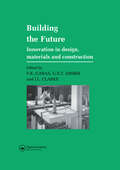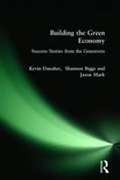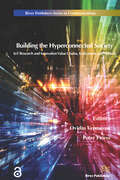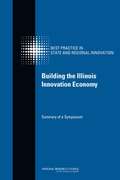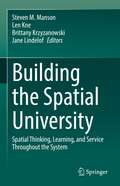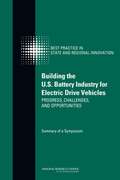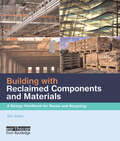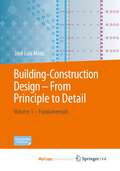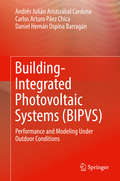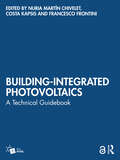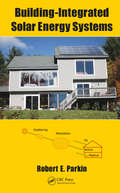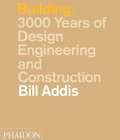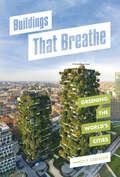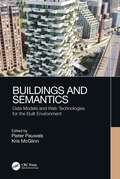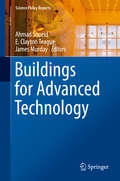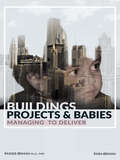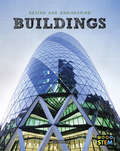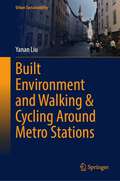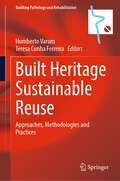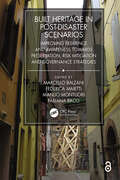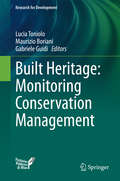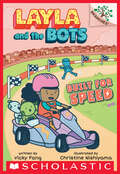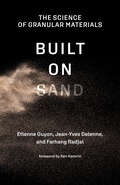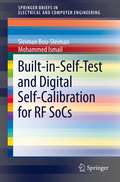- Table View
- List View
Building the Future: Innovation in design, materials and construction
by G. S. T. Armer J. L. Clarke F. K. GarasThis book forms the proceedings of the international seminar held by the Institution of Structural Engineers and the Building Research Establishment in Brighton in April 1993. It brings together contributions from 20 countries on recent innovations in building and construction.
Building the Green Economy
by Kevin Danaher Shannon Biggs Jason MarkAfter centuries of economic activity based on extraction, exploitation, and depletion, we now face undeniable environmental threats. New business models that save or restore natural resources are critical. But how can we translate that insight into more sustainable practices? Building the Green Economy shows how community groups, families, and individual citizens have taken action to protect their food and water, clean up their neighborhoods, and strengthen their local economies. Their unlikely victories-over polluters, unresponsive bureaucracies and unexamined routines-dramatize the opportunities and challenges facing the local green economy movement.
Building the Hyperconnected Society- Internet of Things Research and Innovation Value Chains, Ecosystems and Markets
by Ovidiu Vermesan Peter FriessThis book aims to provide a broad overview of various topics of Internet of Things (IoT), ranging from research, innovation and development priorities to enabling technologies, nanoelectronics, cyber-physical systems, architecture, interoperability and industrial applications. All this is happening in a global context, building towards intelligent, interconnected decision making as an essential driver for new growth and co-competition across a wider set of markets. It is intended to be a standalone book in a series that covers the Internet of Things activities of the IERC – Internet of Things European Research Cluster from research to technological innovation, validation and deployment.The book builds on the ideas put forward by the European Research Cluster on the Internet of Things Strategic Research and Innovation Agenda, and presents global views and state of the art results on the challenges facing the research, innovation, development and deployment of IoT in future years. The concept of IoT could disrupt consumer and industrial product markets generating new revenues and serving as a growth driver for semiconductor, networking equipment, and service provider end-markets globally. This will create new application and product end-markets, change the value chain of companies that creates the IoT technology and deploy it in various end sectors, while impacting the business models of semiconductor, software, device, communication and service provider stakeholders. The proliferation of intelligent devices at the edge of the network with the introduction of embedded software and app-driven hardware into manufactured devices, and the ability, through embedded software/hardware developments, to monetize those device functions and features by offering novel solutions, could generate completely new types of revenue streams. Intelligent and IoT devices leverage software, software licensing, entitlement management, and Internet connectivity in ways that address many of the societal challenges that we will face in the next decade.
Building the Illinois Innovation Economy
by Charles W. WessnerResponding to the challenges of fostering regional growth and employment in an increasingly competitive global economy, many U. S. states and regions have developed programs to attract and grow companies as well as attract the talent and resources necessary to develop innovation clusters. These state and regionally based initiatives have a broad range of goals and increasingly include significant resources, often with a sector focus and often in partnership with foundations and universities. These are being joined by recent initiatives to coordinate and concentrate investments from a variety of federal agencies that provide significant resources to develop regional centers of innovation, business incubators, and other strategies to encourage entrepreneurship and high-tech development. Building the Illinois Innovation Economy is a study of selected state and regional programs to identify best practices with regard to their goals, structures, instruments, modes of operation, synergies across private and public programs, funding mechanisms and levels, and evaluation efforts. This report reviews selected state and regional efforts to capitalize on federal and state investments in areas of critical national needs. This review includes both efforts to strengthen existing industries as well as specific new technology focus areas such as nanotechnology, stem cells, and energy in order to improve our understanding of program goals, challenges, and accomplishments. As a part of this review, The Committee on Competing in the 21st Century: Best Practice in State and Regional Innovation Initiatives is convening a series of public workshops and symposia involving responsible local, state, and federal officials and other stakeholders. These meetings and symposia will enable an exchange of views, information, experience, and analysis to identify best practice in the range of programs and incentives adopted. Building the Illinois Innovation Economy summarizes discussions at these symposia, fact-finding meetings, and commissioned analyses of existing state and regional programs and technology focus areas, the committee will subsequently produce a final report with findings and recommendations focused on lessons, issues, and opportunities for complementary U. S. policies created by these state and regional initiatives.
Building the Spatial University: Spatial Thinking, Learning, and Service Throughout the System
by Steven M. Manson Len Kne Brittany Krzyzanowski Jane LindelofThis volume discusses the concept of The Spatial University as part of the broad growth of spatial science and the need for spatial infrastructure in colleges and universities. The book centers on the development of U-Spatial, the spatial science infrastructure at the University of Minnesota that offers a range of spatial activities and services, including data access, training, and community building. Against a backdrop of the changing nature of research, teaching, and service in higher education, the story of U-Spatial anchors a broader discussion of what it means to be a spatial university. This narrative framing demonstrates—with specific examples—the importance of institutions offering dedicated spatial research infrastructure. In six chapters, the text explores the importance of spatial thinking, learning, and research for student and researcher success. The volume offers lessons that are applicable far beyond the University of Minnesota to apply to a broad array of domains and institutional specializations. The book will be useful to students, researchers, and policymakers concerned with how institutions can encourage spatial research, teaching, and service. It will also appeal to researchers and practitioners interested in broader uses of spatial science.This book shows how GIS can transform a university, speaking to the need for leadership in higher education around the power of bringing everything together using spatial and geographic concepts. Jack Dangermond Co-Founder and President, Esri
Building the U.S. Battery Industry for Electric Drive Vehicles: Summary of a Symposium
by Charles W. WessnerSince 1991, the National Research Council, under the auspices of the Board on Science, Technology, and Economic Policy, has undertaken a program of activities to improve policymakers' understandings of the interconnections of science, technology, and economic policy and their importance for the American economy and its international competitive position. The Board's activities have corresponded with increased policy recognition of the importance of knowledge and technology to economic growth. The goal of the this symposium was to conduct two public symposia to review and analyze the potential contributions of public-private partnerships and identify other relevant issues for the Department of Energy, Office of Vehicle Technologies, Energy Storage Team's activities in the energy storage research and development area. The symposia will also identify lessons from these and other domestic and international experiences to help inform DoE as to whether its activities are complete and appropriately focused. Additional topics that emerge in the course of the planning may also be addressed. Building the U. S. Battery Industry for Electric Drive Vehicles: Summary of a Symposium gathers representatives from leading battery manufacturers, automotive firms, university researchers, academic and industry analysts, congressional staff, and federal agency representatives. An individually-authored summary of each symposium will be issued. The symposium was held in Michigan in order to provide direct access to the policymakers and industrial participants drawn from the concentration of battery manufacturers and automotive firms in the region. The symposium reviewed the current state, needs, and challenges of the U. S. advanced battery manufacturing industry; challenges and opportunities in battery R&D, commercialization, and deployment; collaborations between the automotive industry and battery industry; workforce issues, and supply chain development. It also focused on the impact of DoE's investments and the role of state and federal programs in support of this growing industry. This task of this report is to summarize the presentations and discussions that took place at this symposium. Needless to say, the battery industry has evolved very substantially since the conference was held, and indeed some of the caveats raised by the speakers with regard to overall demand for batteries and the prospects of multiple producers now seem prescient. At the same time, it is important to understand that it is unrealistic to expect that all recipients of local, state, or federal support in a complex and rapidly evolving industry will necessarily succeed. A number of the firms discussed here have been absorbed by competitors, others have gone out of business, and others continue to progress.
Building with Reclaimed Components and Materials: A Design Handbook for Reuse and Recycling
by Bill AddisInterest in green and sustainable design is growing throughout the world. Both national and local governments are active in promoting reuse and recycling in order to reduce the amount of waste going to landfill. This guide identifies how building designers and constructors can minimize the generation of waste at the design stage of a building project by using reclaimed components and materials. Authoritative, accessible and much-needed, this book highlights the opportunities for using reclaimed components and materials and recycled-content building products for each element of a building, from structure and foundations to building services and external works. Current experience is illustrated with international case studies and practical advice. It discusses different approaches to designing with recycling in mind, and identifies the key issues to address when specifying reclaimed components and recycled materials in construction work. This book will be invaluable for building professionals � including architects, specifiers, structural and service engineers, quantity surveyors, contractors and facilities managers � as well as students of architecture and civil engineering. Published with NEF
Building-Construction Design - From Principle to Detail: Volume 1 – Fundamentals
by José Luis MoroConstruction is the means by which designing architects and engineers transforma design idea into built reality. It is from this perspective that the subject of'building construction design' is dealt with by the architect José Luis Moro inthree comprehensive volumes. Each is dedicated to the methodological,physical and functional fundamentals, the conception of a constructionalsolution, and finally its implementation in the constructional detail. Not only do the three volumes provide extensive content; they also ensure the greatest possible clarity in the text and graphics, in order to make it easier for learners to access the material. Importantly, they focus not only on conveying technical and scientific information, but also on demonstrating the complex relationships and interactions between design, material and construction. Great importance was attached to developing consistent, overarching and meaningful correlations between the numerous and highly diverse topics covered. After an introduction to planning theory topics, Volume 1 ("Fundamentals") addresses sustainability issues in the context of constructional design. This is followed by a discussion of the most important material-related considerations and their consequences for the constructional application of the materials. The range of currently available industrial building products is also presented. Furthermore, the essential requirements and functions that building structures must fulfill from a structural, building physics, building acoustics and fire protection perspective are examined. In closing, the book considers questions of durability.
Building-Integrated Photovoltaic Systems (BIPVS)
by Andrés Julián Aristizábal Cardona Carlos Arturo Páez Chica Daniel Hernán Ospina BarragánThis book discusses building-integrated photovoltaic systems (BIPV) and provides solutions for solving problems related to designing, sizing and monitoring a BIPV that has been used to replace conventional building materials in parts of the building envelope such as the roof, skylights or facades. The book begins by introducing the basics to readers interested in learning about this technology and then outlines in an accessible way, a practical development plan for the installation and monitoring of these systems in residential, industrial, and commercial buildings. Chapters discuss the needs of installing, designing, and sizing and provide a financial analysis for a successful implementation of a BIPV system. This book is a useful tool for renewable energy designers, energy contractors, architects, government institutions, and those in the academic community who are interested in seamlessly integrating solar panels into the construction phase of new building projects or retrofitted into existing buildings.
Building-Integrated Photovoltaics: A Technical Guidebook
by Nuria Martín Chivelet Costa Kapsis Francesco FrontiniBuilding-integrated photovoltaics (BIPV) is an innovative technology offering a variety of building envelope solutions, materials, and colours for virtually any building surface. These BIPV products generate on-site renewable electricity, turning buildings from energy consumers to producers. BIPV is expected to play an indispensable role in the transition towards decarbonisation and energy resilience of cities, effectively reducing energy consumption and greenhouse gas emissions. Lack of knowledge and guidance on designing BIPV systems has hindered this technology's widespread adoption and creative applications. As a remedy, this guidebook presents best practices and decision-making processes for efficient and resilient architecture. Featuring more than 50 annotated reference drawings—roofs, solar shadings, rainscreen façades, curtain walls and double skin façades—and 24 international BIPV case studies, the guidebook provides building professionals with the technical knowledge and inspiration to implement BIPV technology in the built environment.
Building-Integrated Solar Energy Systems
by Robert E. ParkinThis book presents techniques for building and optimizing structures with integrated solar energy systems. It describes active solar systems such as photovoltaics and parabolic concentrators as well as passive solar systems and covers optimal materials to use, daylighting, shading, solar blinds, rock and water energy storage and more. It discusses the best ways to site a solar structure considering exposure, elevation, slope, clearance, wind protection, etc. The book includes numerous full-color figures and more than 100 MATLAB® files.
Building: 3,000 Years of Design, Engineering and Construction
by Bill AddisCambridge International AS and A Level Business Studies Revision Guide has been designed to help students prepare for Cambridge International AS and A Level Business Studies (9707) examinations. Written in an easy-to-follow style, the book helps in reinforcing students' understanding and provides guidance on revision.
Buildings That Breathe: Greening the World's Cities
by Nancy F. CastaldoImagine looking out from your 18th floor apartment in the middle of the city and seeing trees right in front of you. In an effort to stem climate change, reduce pollution, combat heat, and protect biodiversity, architects are teaming up with botanists, urban wildlife ecologists, and other scientists to design high-rise forests, living walls, and vertical farms in some of the world’s most populated places. These projects are happening all around the world, and they will not only change the urban landscape, but they will provide urban dwellers with a healthier place to live and work. For Buildings That Breathe, author and environmental journalist Nancy Castaldo connected with architect Stefano Boeri at the World Forum on Urban Forests and was invited to his office in Milan where she visited Bosco Verticale, the first high-rise forest. Planted with 750 trees, 5,000 shrubs, and 11 perennials on two apartment towers, the project provides an urban habitat for birds, insects, and people while creating a micro-climate that produces oxygen and provides shade for high-rise residents. Explore Bosco Verticale, as well the planned Liuzhou Forest City in China and other green architecture projects around the world, looking at how people are working together to change the urban landscape of the future.
Buildings and Semantics: Data Models and Web Technologies for the Built Environment
by Pieter PauwelsThe built environment has been digitizing rapidly and is now transforming into a physical world that is at all times supplemented by a fully web-supported and interconnected digital version, often referred to as Digital Twin. This book shows how diverse data models and web technologies can be created and used for the built environment. Key features of this book are its technical nature and technical detail. The first part of the book highlights a large diversity of IT techniques and their use in the AEC domain, from JSON to XML to EXPRESS to RDF/OWL, for modelling geometry, products, properties, sensor and energy data. The second part of the book focuses on diverse software solutions and approaches, including digital twins, federated data storage on the web, IoT, cloud computing, and smart cities. Key research and strategic development opportunities are comprehensively discussed for distributed web-based building data management, IoT integration and cloud computing. This book aims to serve as a guide and reference for experts and professionals in AEC computing and digital construction including Master's students, PhD researchers, and junior to senior IT-oriented AEC professionals.
Buildings for Advanced Technology (Science Policy Reports)
by Ahmad Soueid E. Clayton Teague James MurdayThis book deals with the design and construction of buildings for nanoscale science and engineering research. The information provided in this book is useful for designing and constructing buildings for such advanced technologies as nanotechnology, nanoelectronics and biotechnology. The book outlines the technology challenges unique to each of the building environmental challenges outlined below and provides best practices and examples of engineering approaches to address them: * Establishing and maintaining critical environments: temperature, humidity, and pressure * Structural vibration isolation * Airborne vibration isolation (acoustic noise) * Isolation of mechanical equipment-generated vibration/acoustic noise * Cost-effective power conditioning * Grounding facilities for low electrical interference * Electromagnetic interference (EMI)/Radio frequency interference (RFI) isolation * Airborne particulate contamination * Airborne organic and chemical contamination * Environment, safety and health (ESH) considerations * Flexibility strategies for nanotechnology facilities The authors are specialists and experts with knowledge and experience in the control of environmental disturbances to buildings and experimental apparatus.
Buildings for Education: A Multidisciplinary Overview of The Design of School Buildings (Research for Development)
by Stefano Della Torre Massimiliano Bocciarelli Laura Daglio Raffaella NeriThis open access book presents theoretical and practical research relating to the vast, publicly financed program for the construction of new schools and the reorganization of existing educational buildings in Italy. This transformative process aims to give old buildings a fresh identity, to ensure that facilities are compliant with the new educational and teaching models, and to improve both energy efficiency and structural safety with respect to seismic activity. The book is divided into three sections, the first of which focuses on the social role of the school as a civic building that can serve the needs of the community. Innovations in both design and construction processes are then analyzed, paying special attention to the Building Information Modeling (BIM) strategy as a tool for the integration of different disciplines. The final section is devoted to the built heritage and tools, technologies, and approaches for the upgrading of existing buildings so that they meet the new regulations on building performance. The book will be of interest to all who wish to learn about the latest insights into the challenges posed by, and the opportunities afforded by, a comprehensive school building and renovation program.
Buildings, Projects, and Babies: Managing to Deliver
by Yara Osman Yasser OsmanOffering tips and strategies in this manual for project managers, The Author -An experienced project manager- who has worked on many construction sites, never uses the word “problem” for the hurdles that come up during the building process. He prefers the term “issues,” because to call something a problem is to expect no solution, and a project manager has no such luxury. Balancing between the Moving Wealth (Team) and Fixed Wealth (Thing), this book, seeks to explain the role of the project manager and to offer strategies for those who fill that role. The Book has a favourite metaphor for his field: “the construction site itself can be seen as a kind of ‘delivery room.’ ” The building’s architect is the doctor; the client is the father; the contractor is the mother. The project manager, whose responsibilities are the focus of the book, is the equivalent of the delivery room nurse “in their ability to monitor events, and to identify issues that require immediate solutions, find those solutions, and implement them.” The Book runs through a series of situations in which various construction-related problems arise and walks the reader through the ways to fix them. By keeping a cool head and falling back on fundamentals like foresight, planning, and creative thinking, a manager can always keep the project on schedule and on budget. The book is written specifically for project managers working in the construction industry, but the fundamental managerial skills are applicable in any situation that involves a large team and accountability to a third party. This book is trying to reflect a quick, comprehensive guide to successful project management.
Buildings: Design and Engineering for STEM (Design and Engineering for STEM)
by Alex WoolfDid you know that every building has a life cycle? That's what we call the stages from its design, construction, and opening to its use, maintenance, and demolition and disposal at the end of its useful life. This book explains what happens during these stages, such as planning, the sourcing of materials, the construction process, the decisions made by designers and engineers, and refurbishing and recycling.
Built Environment and Walking & Cycling Around Metro Stations (Urban Sustainability)
by Yanan LiuThis book explores the relationship between pedestrians/cyclists’ mode and route choice to/from metro/railway stations and the micro-level (street-scale) built environment in a second-tier city in China. More specifically, it investigates how the street-scale built environment influences pedestrians/cyclists’ mode choice and route choice behavior and examines user preferences for the micro-level built environment around metro stations. The focus on a second-tier city is motivated primarily to expand the set of Chinese cities where the effects of the built environment on pedestrian/cyclist mode and route choice have been studied. Results demonstrate the effects of the street-scale built environment on pedestrian flows. The effects are higher for the main road, which is directly connected with the metro station. The findings of this book are expected to support the design of preferred walking/biking built environments around a metro station. This book appeals to urbanists, planners, engineers, policy makers, and those interested in a wide-ranging overview of slow/green transportation and built environment promotion. These methods not only help to understand the quantitative relationship between built environment design and travel behavior but also support the evaluation and assessment of built environment design in urban planning projects. It reduces the gap in our understanding of the quantitative relationship between the micro-level built environment and pedestrians/cyclists’ transportation mode and route choice around the metro station. Both stated choice data and revealed choice data were used. An extended set of micro-level built environment attributes was developed. Besides the widely studied transportation-related factors, street-level built environment factors were studied using quantitative methods.
Built Heritage Sustainable Reuse: Approaches, Methodologies and Practices (Building Pathology and Rehabilitation #26)
by Humberto Varum Teresa Cunha FerreiraThis book gathers the latest advances and innovations in the field of sustainable reuse of built heritage, as presented by international researchers at the conference "ReUSO - Documentation, Restoration and Reuse of Heritage”, held on November 2-4, 2022, at the Faculty of Engineering of the University of Porto (FEUP), Porto, Portugal. The X edition of the ReUSO conference promoted the discussion among the participants on issues related to the sustainable and adaptive reuse of built heritage, from the theoretical perspectives to the methodological and practical applications in contemporary interventions in relation to the complexity and vulnerability of the present-day context and the future orientations of our scientific sectors.
Built Heritage in post-Disaster Scenarios: Improving Resilience and Awareness Towards Preservation, Risk Mitigation and Governance Strategies
by Marcello BalzaniIt is assumed that the impact of natural and man-made hazards on society in terms of damage cannot be avoided. To reduce potential disaster levels and to assess which policies have had a positive outcome, a careful comparison should take place on the procedures implemented in the management of crises.The experiences with the earthquakes in the Pianura Padana area and central regions of Italy in the last ten years have been incorporated in the 'After the Damages' advanced training project. This project aims to showcase recent innovations and advancements in post-disaster management, so as to take a more proactive role in post-disaster management, and to respond more effectively when disasters occur.This volume provides insights into the dynamics and negative effects of natural and man-made hazards (i.e., earthquakes, fires, floods, droughts, volcanic eruptions, etc.), including more updated approaches to deal with post-disaster phases. The book also offers tools to deal with possible international crisis scenarios and mitigate the social impact of vulnerabilities through risk reduction.Built Heritage in post-Disaster Scenarios aims at public administration managers, government agency representatives, international organizations, researchers, and professionals in architecture, engineering, and earth science.Marcello Balzani, Architect, PhD in "Representation and Survey", Full Professor of Representation at the Department of Architecture, University of Ferrara. President of Clust-ER Building and Construction. He is author of more than 200 publications on the themes of Drawing and Architectural and Urban Surveying, Project Representation, Management and Visualisation.Federica Maietti, Architect, PhD, Associate Professor in the Scientific Sector ICAR/17 at the Department of Architecture, University of Ferrara. Member of the DIAPReM Centre, since 2005 she carries out research activities in the fields of heritage documentation, survey and diagnostic investigations, in different national and international contexts, including Pompeii, Malta, Brazil, India, and Mexico. Scientific Manager of the International Academy "After the Damages", she is involved in several research activities and she is the author of more than two hundred publications in the field of Heritage Documentation, Survey and Representation.Manlio Montuori, Architect, PhD, former assistant professor non-tenured at the University of Ferrara, Department of Architecture, where he is a member of the Labo.R.A. The main field of his research is the conservation of architectural heritage and landscape, with special emphasis on preservation procedures for traditional and industrial built heritage. His research interests also address assessment and management in the context of damage and disaster risk reduction. Scientific Manager of the International Academy "After the Damages", he is involved in several research projects implementing ICT technologies in the conservation and structural health assessment of built and cultural heritage.Fabiana Raco, Architect, PhD RTDa Researcher of Drawing at the Department of Architecture, University of Ferrara. Technical coordinator of TekneHub Laboratory. Author of more than 50 publications on the topics of Drawing, Architectural and Urban Surveying, Representation, Diagnostics, Visualization and Project Management of interventions on built heritage.
Built Heritage: Monitoring Conservation Management (Research for Development)
by Lucia Toniolo Maurizio Boriani Gabriele GuidiThis book provides a comprehensive, up-to-date overview on the most pressing issues in the conservation and management of archaeological, architectural, and urban landscapes. Multidisciplinary research is presented on a wide range of built heritage sites, from archaeological ruins and historic centers through to twentieth century and industrial architectural heritage. The role of ICT and new technologies, including those used for digital archiving, surveying, modeling, and monitoring, is extensively discussed, in recognition of their importance for professionals working in the field. Detailed attention is also paid to materials and treatments employed in preventive conservation and management. With contributions from leading experts, including university researchers, professionals, and policy makers, the book will be invaluable for all who seek to understand, and solve, the challenges face d in the protection and enhancement of the built heritage.
Built for Speed: A Branches Book (Layla and the Bots #2)
by Vicky FangReady, set, go! Layla and the Bots are heading to the races!Pick a book. Grow a Reader!This series is part of Scholastic's early chapter book line Branches, aimed at newly independent readers. With easy-to-read text, high-interest content, fast-paced plots, and illustrations on every page, these books will boost reading confidence and stamina. Branches books help readers grow!Blossom Valley is hosting a go-kart race! The go-karts are provided for all the kids in town. Layla and the Bots can't wait for race day! But one racer, Tina, needs their help. She needs a new cart that uses hand-controls and other cool features. Layla and the Bots know just what to do... they will build her a brand-new cart that's even faster than her wheelchair! But will Tina's go-kart have enough speed to win the race? With full-color artwork on every page and speech bubbles throughout, this early chapter book series brings kid-friendly STEAM topics to young readers!
Built on Sand: The Science of Granular Materials
by Etienne Guyon Jean-Yves Delenne Farhang RadjaiExplaining the science contained in a simple assembly of grains—the most abundant form of matter present on Earth.Granular media—composed of vast amounts of grains, consolidated or not—constitute the most abundant form of solid matter on Earth. Granular materials assemble in disordered configurations scientists often liken to a bag of marbles. Made of macroscopic particles rather than molecules, they defy the standard scheme of classification in terms of solid, liquid, and gas. Granular materials provide a model relevant to various domains of research, including engineering, physics, and biology. William Blake famously wished “To See a World in a Grain of Sand”; in this book, pioneering researchers in granular matter explain the science hidden behind simple grains, shedding light on collective behavior in disordered settings in general.The authors begin by describing the single grain with its different origins, shapes, and sizes, then examine grains in piled or stacked form. They explain the packing fraction of granular media, a crucial issue that bears on the properties displayed in practical applications; explore small-scale deformations in piles of disordered grains, with particular attention to friction; and present theories of various modes of disorder. Along the way, they discuss such concepts as force chains, arching effects, wet grains, sticky contacts, and inertial effects. Drawing on recent numerical simulations as well as classical concepts developed in physics and mechanics, the book offers an accessible introduction to a rapidly developing field.
Built-in-Self-Test and Digital Self-Calibration for RF SoCs (SpringerBriefs in Electrical and Computer Engineering)
by Mohammed Ismail Sleiman Bou-SleimanThis book will introduce design methodologies, known as Built-in-Self-Test (BiST) and Built-in-Self-Calibration (BiSC), which enhance the robustness of radio frequency (RF) and millimeter wave (mmWave) integrated circuits (ICs). These circuits are used in current and emerging communication, computing, multimedia and biomedical products and microchips. The design methodologies presented will result in enhancing the yield (percentage of working chips in a high volume run) of RF and mmWave ICs which will enable successful manufacturing of such microchips in high volume.
